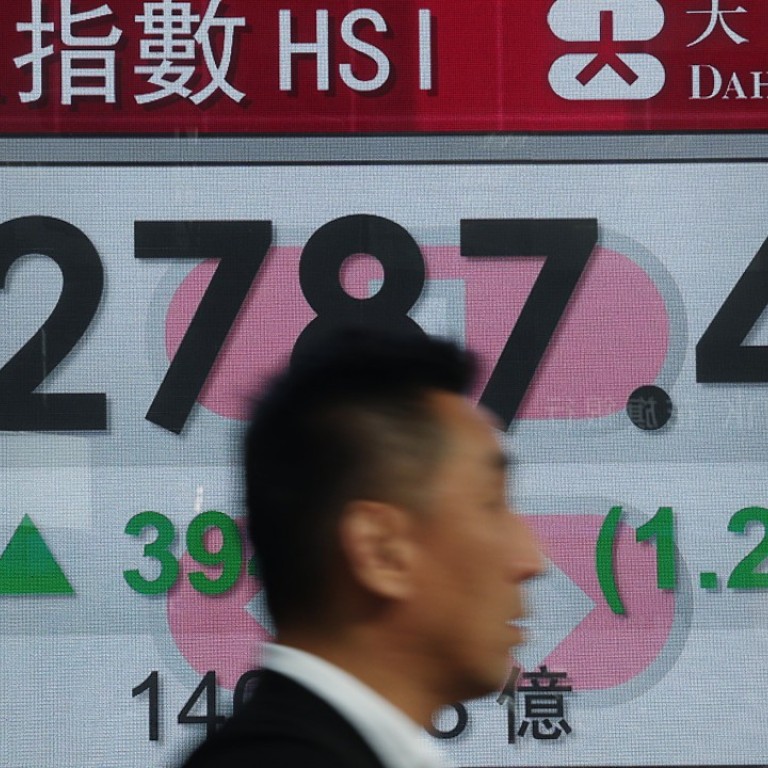
Happy days are here again as Hang Seng’s prospects remain strong
In 2017 alone, the market hardly missed a beat, up a whopping 36pc and the economic news coming out of the rest of the world is highly supportive
The investing world has been pretty eventful in 2018 so far, but the Hang Seng Index is only up 4 per cent – not an awful lot seems to have happened.
Yes, the benchmark Hong Kong stock index saw a ridiculous 9 per cent rise in January but it then plummeted 11 per cent from top to bottom. Then recovered. We are now back to the races. Happy days are here again …
Since the dark old days of February 2016, when the market languished at 19,500, we had gone through a period of historically low volatility combined with an extraordinary run of 60 per cent upwards, on the back of the red chips.
In 2017 alone, the market hardly missed a beat, up a whopping 36 per cent, with the biggest drawdown being 4 per cent, when the market didn’t quite have enough energy to break 30,000. The western new year provided the impetus to drive the index up 10 per cent over that invisible barrier.

Such a rise would have most people thinking we are now in the stage of picking up pennies in front of a heavy roller. Yet the market does not seem to want to go down.
Even during the big fall of early February, we saw the 29,000 range for just three days, only for it to recover by Valentine’s Day. We can’t forecast the future but it looks likely the 30,000 is now more of a floor, than a ceiling.
We shouldn’t be terribly surprised. Since the end of 2012 when the Hang Seng was at 22,600, it has returned just 4.74 per cent per annum before inflation – pathetic.
The only real volatility was in 2015 during the misguided attempt by the mainland authorities to force the domestic market up – which ended in tears. We can’t say that Hong Kong equities have provided much of a return long term in a city devoted to enriching the rich.
More importantly, the economic news coming out of the rest of the world is highly supportive. The investment strategist Cook’s Tour begins in the US with a rampant Donald Trump, pushing through his US$1.5 trillion tax cut.
More worrying for us in Hong Kong, is that while the Muller investigation fallout is causing Trump to cower from the Russians, he is likely to be much braver against the Chinese
There are naysayers poo-pooing the tax break, but the imposition of taxes was the catalyst for the American Revolution against the British, so cuts should be thought as being good news to Americans.
Sailing across the ditch to Europe we again find a bullish economy with interest rates in positive territory and inflation definitely rising.
In Europe these are seen as good signals. For a little while in some parts of the continent, banks have been paying people to take out loans. These signs of normality have led the European Central Bank to think its measures are working – although like the doctor that buries his mistakes, a patient that takes 10 years to heal has probably healed himself.
The UK remains snared by Brexit with its leaders stepping on a new banana skin weekly. The country remains in a no-win situation while negotiations continue, and continue, and continue, but the pound will take the hit rather than the domestic economy.
The global investor now takes the slow boat to China where growth is speeding up. The market has driven Hong Kong’s northwards and recent management by the People’s Bank of China and the Central Government has been careful and correct, which will assist the thankless task of reducing the massive debt in the economy.
Tit-for-tat limited sanctions against each other’s goods are unlikely to hinder a booming US economy and that is good for China
Emerging market currencies are likely to do well at this stage of the cycle. They always do. India had a good run last year on the back of small reforms and the oil emerging economies, Brazil, Indonesia and Russia continue to thrive on the oozing price of black gold.
Further inflation frenzies will nag investors concerned that rising interest rates will upset economic growth.
The dark news is the huge debt levels held around the world – but that sword will not fall … just yet. Trump is likely to push a trillion dollar infrastructure bill that (if you are a Keynesian) will certainly add to economic growth (and push inflation and interest rates up). Think “volatile but positive”.
More worrying for us in Hong Kong, is that while the Muller investigation fallout is causing Trump to cower from the Russians, he is likely to be much braver against the Chinese.
Yet tit-for-tat limited sanctions against each other’s goods are unlikely to hinder a booming US economy and that is good for China. But if we never had any bad news, the market would never go down, would it?
Richard Harris is a veteran investment manager, banker, writer and broadcaster and financial expert witness.

